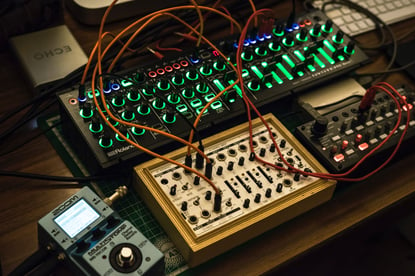You’re a musician (or aspiring to be one). You’re learning about music composition. But then you come across two terms: Polyphonic and monophonic. What are these two terms? And how are they significant to the world of music?
The truth is, these are just some of many musical terms that you’ll hear about when producing music. When it comes to synth and music arrangement specifically, you’ll need to learn these two terms by heart.
But not to worry!
This quick post will give you a rundown of both polyphonic and monophonic. Let’s dive right in!

“Mono” And “Poly”
“The term mono means ‘one’ or ‘single,’” says Kathy Gibbons, a music blogger at Write My X and 1day2write. “That means that monophony is another word for music with a single vocal melody, or that with a single instrumental melody. On the other hand, polyphony refers to music with more than one part, thus playing simultaneous notes.”
Now, let’s look at both of these music terms on an individual basis:
Polyphonic
Polyphony in music refers to the following factors:
Having a number of individual voices (not singers) in a musical texture, AND
Being the distinct parts in a musical composition, or the number of instrumental voices
As for the “voices,” what’s implied here are the four standard voice types in chorale music:
Soprano
Alto
Tenor, AND
Bass
With that said, polyphony is mostly associated with synths, samplers and VSTs, in terms of understanding what an instrument can do.
Monophonic
Monophonic, on the other hand, deals with one note at a time. If you use synthesizers (or virtual instruments), know that your first synthesizer design is monophonic, meaning that they can only play one note at a time. Beyond that, many of the classic sounds from synths came from monophonic instruments.

FAQs On Polyphonic
How does polyphonic differ from monophonic?
Monophony means music with a single "part" and a "part" typically means a single vocal melody, but it could mean a single melody on an instrument of one kind or another. Polyphony means music with more than one part, and so this indicates simultaneous notes.
Difference between polyphonic and heterophonic?
Polyphonic is different than heterophony, because it has two or more voices. Whereas, heterophony is what all voices play based upon the same melody (although some of these same notes may not be played).
FAQs On Monophonic
How does one distinguish a monophonic synth?
A synth equivalent to the human voice, a monophonic synth must produce one note at a time. In that case, the human voice wouldn’t be able to achieve polyphony, because it’s not designed to sing or hum two notes or more at the same time.
Are modular synths considered “monophonic”?
Since modular synthesizers are used to put together components to create a single note, then yes, they’re considered monophonic.
What is a good example of monophonic?
Believe it or not, many of the children’s songs and folks’ songs that people will hear today were composed in the monophonic texture. Here are just some examples that follow this particular formula:
ABCs
Kumbaya
Mary Had a Little Lamb
Twinkle, Twinkle Little Star, etc.
As you can see, these songs can be sung by oneself, or be sung in a group. Either way, you’ll notice that the musical notes are monophonic. Otherwise, if you sing or play as a round with other players or singers, then that would be considered polyphonic.

General FAQs
How does homophonic differ from both monophonic and polyphonic?
“Homophonic is different from both monophonic and polyphonic, because part of its name homo means ‘the same,’” says Charlie Phillips, a writer at Originwritings and Britstudent. “In other words, while monophonic is only one sound, and polyphonic many sounds, homophonic refers to the same sound.”
Remember:
“Mono” means “one” or “single.”
“Poly” means “two or more.” AND,
“Homo” means “the same.”
How can you tell if a song is monophonic, polyphonic, or homophonic?
Here’s how you categorize what is monophonic, what is polyphonic, and what is homophonic:
Monophonic – Only one melody is playing
Polyphonic – More than one independent melody is playing simultaneously (e.g., canons, rounds, and fugues)
Homophonic – The same note is playing at the same time
Again, by looking at the prefixes (as discussed in the previous section), you can tell which one is which when categorizing songs and compositions.
Conclusion
So, there you have it!
When it comes to music composition, the words “polyphonic” and “monophonic” aren’t as complicated as one might seem. We hope that you have a better understanding of these musical terminologies in your next music venture. Have fun, aspiring musicians everywhere!
George J. Newton is a writer and editor at Write My Essay and Dissertation Writing Service. He is also a contributing writer for Custom Coursework. As a content writer, he writes articles about music, social media trends, and online content creation.

















_Cropped.png?width=1600&name=02%20(2)_Cropped.png)




















Your Comments :